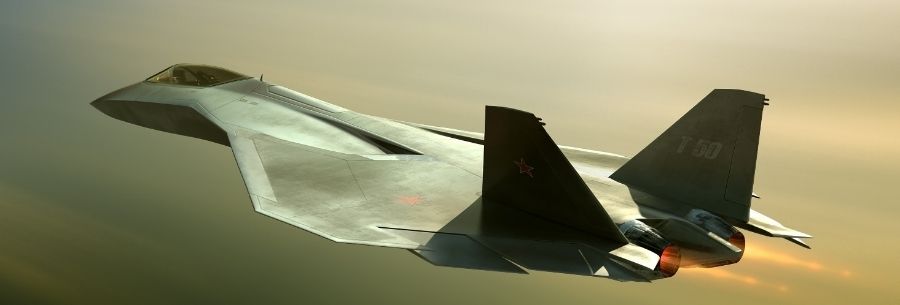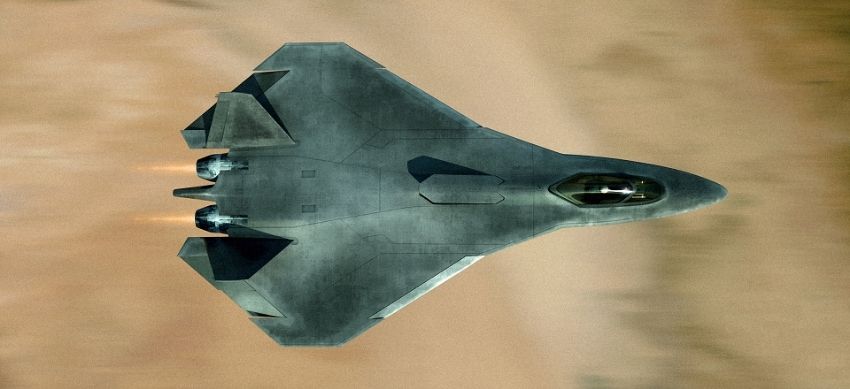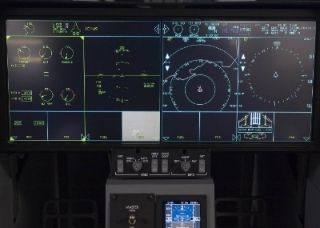Present all orders to the Corporate Home and do not post in this thread. Failure to do such will result in negligence of the order. Thank You.
Z.D.I. F-27 Ghost Bird Air Superiority Fighter
True Stealth. True Force. True Deterrence.
True Stealth. True Force. True Deterrence.
The Greater Eastern Union Air Force's F-27 Ghost Bird seen flying west of La Defense.
UNIT COST: $200,000,000 (F-27A)
DPR: $200,000,000,000
DPR: $200,000,000,000
The ZDI F-27 Ghost Bird is a fifth-generation, twin-engine, supermaneuverable stealth air superiority fighter. Though originally designed primarily for air superiority and electronic warfare, the F-27 is also a highly capable fighter when it comes to anti-surface warfare and ISR (Intelligence, Surveillance, Reconnaissance). Though featuring much of the technology used on the F-26 line, the F-27 yet manages to distinguish itself as a highly capable air superiority fighter that can ensure air dominance.
The F-27 is the product of the Greater Eastern Imperium's Next-Generation Air Dominance Program (NGADP), a program to develop a highly capable air superiority fighter that can easily overwhelm the F-22 Raptor. The program beginning in the early 1990's, it went alongside the Joint Tactical Fighter program, which product was the F-26 Black Eagle. Incorporating technology made from the Joint Tactical Fighter program and proven technology, the NGADP brought the interests of the Navy and the Air Force. The development was successful, as Kronos Aerospace Corporation, which had previously made its bid with the YF-28 Desert Eagle, came together. Making its first flight in January 2nd, 2002 and reaching IOC in the EIAF in 2005, the F-27 Ghost Bird stands as the unchallenged air superiority fighter of the world.
Though it focuses on traditional values for an air superiority fighter (refined all-aspect stealth, super-maneuverability, etc.), the F-27 Ghost Bird brings more emphasis to an unexpected factor among fifth-generation fighters: speed. Constructed to be able to chase and shoot down interceptors such as the MiG-31BM, the F-27 Ghost Bird brings greater emphasis to speed, as it is able to accelerate in speeds up to three times the speed of sound, and cruise in speeds twice the speed of sound. Of course, the high speed comes at the price of fuel and high IR signature, but the F-27 has made significant engineering improvements to compensate for those.
Due to its capability, the Greater Eastern Imperium Navy and Air Force initially planned to procure a combined amount of over 1,600 units. However, due to budgetary problems, the Navy and the Air Force decided to procure more numbers of F-26C Advanced Black Eagles in the place of the F-27 (hence began the development of the F-26C from the F-26A). It is currently on Restriction Level Four, as its high-level technologies make it risky for wide exports.
Contents
History
Development
The F-27 Ghost Bird started off with the Greater Eastern Imperium's Next-Generation Air Dominance Program (NGADP), which started in 1991. The Greater Eastern Imperium Air Force and Navy called for a new tactical fighter that would enable them to stand unchallenged in the air. The objective of the NGADF was to create a highly capable fifth-generation air superiority fighter to build in smaller numbers to complement the smaller, lighter, cheaper F-26 Black Eagle, which Joint Tactical Fighter program went along at the same time.
The Greater Eastern Imperium Air Force and Navy received two major bids - one from Zeus Defense Industries at the form of the F-27 Ghost Bird, and the other from Kronos Aerospace Corporation, which proposed the F-28 Flanker II. Both featured designs that were considered unusual: the F-27 had a large wing to increase lift and control capabilities, while the KAC F-28 had forward-swept wings for better high-speed maneuverability. The Greater Eastern Imperium Air Force and Navy eventually chose the stealthier and faster F-27 Ghost Bird over the more maneuverable and radical F-28 Flanker II.
Making its first flight on January 2nd, 2002, the F-27 Ghost Bird started proving its worth during combat testing within the Greater Eastern Imperium Air Force. On an air combat exercise held in 2006, the F-27 Ghost Bird, using superior stealth, speed, armament and maneuverability, set a 160:1 kill ratio against fourth-generation air superiority fighters, namely the Su-27 and the Su-30. In 2007, the F-27 Ghost Bird finally reached Initial Operational Capability, while larger orders were made by the Greater Eastern Imperium Air Force and Navy. The cost of each individual aircraft at the time of the IOC was well over $350 million; however, massive procurement by the EIDEF, the cost decreased until it maintained an average of $185 million per aircraft.
Operational History
Design
Configurations
The first thing noticeable about the F-27 Ghost Bird is its wings: as noticeable on the picture below, the F-27 does not have horizontal stabilizers. Some may think that this is an illogical design when it comes to maneuverability, but that is not the case with the F-27. The F-27 employs its large body wing structure in order to increase lift through increased wing area, better speeds, more aerodynamics and durability of the wings (similar to the trapezoid-shaped wings employed on most fifth-generation fighters). This is one of the factors that make the F-27 a highly capable fighter that can reach higher altitudes at higher speeds, engage in air combat in higher speeds and lift, and escape for survival on higher speeds and greater rates of survivability. Of course, some of the maneuverability is sacrificed, but such has been more than compensated through advancements in technology, such as increased control surfaces, fly-by-light control systems, thrust vectoring and composite materials.
A picture that shows the F-27's wings well. Click for full resolution.
Aside from its wings, F-27's high capability starts with its propulsion. The F-27, powered by the ZDI F151-200 multi-axis thrust vectoring turbofan engines that provide a maximum of 40,000 lbf each, though rumors claim that it is 44,000 lbf each. Incorporating new material technology and revolutions in aerospace engineering, the ZDI F151-200 managed to significantly reduce the weight increase of the engine, which is proportionate to its thrust. With such, the ZDI F151-200 makes a high thrust-to-weight ratio, making 'Mach 2 Supercruise' and the F-27's maximum speed of Mach 2.5 possible.
Like on the F-26 Black Eagle, the F-27 utilizes three-dimensional thrust vectoring, though on a different method from that of the F-26. The F-26 Black Eagle used three-point thrust vectoring (bringing both thrust vectoring and stealth into the aircraft). The F-27, however, which emphasized supermaneuverability as a counter-stealth air superiority fighter, chose a mix between the F-26's three-point thrust vectoring and conventional 3D thrust vectoring: multi-point thrust vectoring. Multi-point thrust vectoring utilizes not just three points but multiple points for thrust vectoring - just like a three-dimensional nozzle, but with no negative impacts on the F-27's RCS. With this, the F-27 Ghost Bird caught the two birds simultaneously - while maintaining three-dimensional TVC's for high maneuverability, the three-point thrust-vectoring nozzles enabled it to reinforce stealth within its design.
The F-26 Black Eagle is seen as the best example in which fly-by-light control systems are used - however, it was actually the F-27 Ghost Bird on which the fly-by-light systems were tested upon. Also called 'Fly-by-Optics', 'Fly-by-Light' incorporates fiber-optic cables instead of electric cables made of copper. Fly-by-light controls allow for faster and more efficient transfer of information and command, reduce overall internal weight, and are more resistant to electronic jamming and interference. In other words, fly-by-light, for that it uses fiber optic cables instead of heavy copper electric cables, also reduces the weight of such cables, meaning that the saved weight can be used to enhance the F-27's durability, eventually resulting in greater durability of the F-27.
A typical problem with fifth-generation aircraft and semi-stealth aircraft is fuel: since weapons have to be stored internally for stealth, the weapons eat up the area that otherwise would've been used for internal fuel. For such reasons, some aircraft resort to external fuel tanks and/or conformal fuel tanks, which brings a negative impact on aerodynamics. To find an answer to this, the F-27 looked for solutions in the past, and found the P-51 Mustang: instead of creating more space for fuel, the P-51 focused on greater efficiency and aerodynamics to enhance range. The F-27 applied this design philosophy into its configurations as well: finding a balance between stealth and aerodynamics, the F-27 brought aerodynamics to the maximum with its large wing, which lesser maneuverability can be compensated through more control surfaces and thrust vectoring.
The Cockpit
Like the F-26, the F-27 has a full-glass, touchscreen cockpit that utilizes a 'panoramic cockpit display (PCD)', with dimensions of 20 by 8 inches (50 by 20 centimeters). The PCD displays vital flight information (see picture to the right), while its display works together with the pilot's helmet-mounted display (HMD). Its display configuration can be altered through simple ways, allowing the pilot to set the display to his or her preferences. The cockpit layout is built around the display and key systems - simple, yet easy to operate. However, a critical key lies on the fighter's cockpit is the existence of the Head-Up Display (HUD): something that recent fighters like the F-35 had neglected. The HUD enables continued operations even after the technical failure of the sensitive Head-Mounted Display (HMD).
Incorporating similar technologies from the F-26 with some enhancements, the cockpit is also equipped with an onboard voice recognition system (VOIRS). The VOIRS enables F-26 pilots to send commands throughout the aircraft much faster: without pressing buttons or even minding the touch screen, the pilot, using the VOIRS, can speak the command. Working with quick response from the fighter, the VOIRS contributes to simpler, faster controls of the aircraft.
The F-27 is equipped with a right-hand side stick controller, similar to that of the F-35 Lightning II. The ZDI35 ejection seat - a modified version of that on the F-26 - is employed on the F-27 Ghost Bird. The ZDI35 seat design balances prime performance requirements, including safe-terrain-clearance limits, pilot-load limits, and pilot size; to propel itself and the pilot, it uses a twin-catapult system housed in side rails.
The canopy is made of bullet-resistant polycarbonate with glass coating and a stealthy tint, protecting the occupant from sunlight, lasers, electronic waves and even limited protection against enemy gunfire. The canopy consists of a frameless single-piece bubble canopy, frameless to increase pilot visibility. The frontal portion has been upgraded to be resistant to bird strikes and even gunfire (to a limited extent). The canopy shatters upon ejection with integrated explosive systems, allowing the pilot to eject at all speeds (even low speed), including while the aircraft is parked on the ground; this is commonly known as "zero-zero" capability.
Armament
Incorporating lessons learned from a lack of guns, the F-27 Ghost Bird is armed with a M61A2 20 mm Gatling Gun - the same gun on the F-22 Raptor - with 670 rounds. All variants of the F-27 carry the M61A2: in other words, the gun is automatically within the fighter. However, a notable difference in the gun part is that it is somewhat 'modularized': it can be interchanged with other guns of different calibers, though most commonly the GAU-12 and the GSh-30-1. With a gun, the F-27 Ghost Bird has set its Maginot line in air-to-air warfare, when all missiles have failed.
The F-27, due to its large airframe size, has two types of internal weapon bays: the central and the side internal bay. The central bay is divided in two (front and back), with six and four hardpoints each holding up to 2,500 pounds respectively. In air-to-air loading, it is capable of loading up to 10 BVRAAMs in its central bay alone, while it can carry up to five 2,000 lb bombs in its internal bay (this is due to restraints in space). The side internal bay was originally made for SRAAM's: however, in some cases, BVRAAMs can also be loaded within the side bay. Therefore, in maximum configuration, the F-27 can carry up to 12 BVRAAMs - if counting external loading (which can bring the number up to 20), the F-27 can additionally serve as a missile truck for those that cannot afford high-level bombers.
Avionics and Electronics
As a highly capable fifth-generation fighter, the F-27 is equipped with several key avionics, the first in which is the Rayman AN/APG-99 Advanced Combat AESA Radar (ACAR), a highly capable active electronically-scanned radar centered on air superiority missions. Capable of instantaneously scanning 120° of airspace by electronically forming multiple beams and utilizing agile beam steering to simultaneously detect multiple threats and track priority targets, the AN/APG-99 can track down enemy fighters at distances as far as 480 kilometers (experiment result against Su-27 Flankers in 2009), depending on the aircraft's radar cross section. It eliminates all mechanical control parts due to its use of electronic scanning. Though the ACAR is centered on air-to-air combat, it remains capable of tracing targets on the ground, bringing the ACAR's seeking capability even against the ground. In terms of overall power, the ACAR contains about 2400 transmit/receive modules, indicating the ACAR's greater capability.
In addition to the radar, several other sensors accompany the F-27: one of them is the Paladin AN/AAQ-43E Evolved Distributed Watcher System (EDWS), which also takes the role of a MLD, RWR and IRST as well. Similar to the AN/AAQ-37 Distributed Aperture System on the F-35 Lightning II, the AN/AAQ-43E is an evolved version of the AN/AAQ-43 on the F-26. A multirole sensor, the AN/AAQ-43E provides a 360-degree, spherical coverage around the aircraft without any pilot input needed. The AN/AAQ-43E has greater detection range, resolution and responsive time than the F-26's AN/AAQ-43, making it appropriate for an air superiority fighter.
Furthermore, another notable piece of avionics on the F-27 is the Paladin AN/ASQ-347E 'Poseidon' Electronic Warfare Suite. The AN/ASQ-347E 'Poseidon' makes the F-27 capable of stand-off jamming for other aircraft — providing 10 times the effective radiated power of any previous fighter — it can jam every enemy electronic devices in closer proximity to the threat (this is also known as ‘stand-in’) to provide jamming power many multiples that of any previous fighter. With the AN/ASQ-347E 'Poseidon' built within it, the F-27 is protected from almost all anti-air systems in the battlefields of today.
Variants
- F-27A: Single-seat variant.
- F-27B: Twin-seat variant. Designated closer to strike roles.
- F-27N Sea Ghost: Naval variant co-developed with Trenton Aerospace of Mallaska.
Specifications
General Specifications
- Crew: 1 (2 on F-27B)
- Length: 20.2 m
- Wingspan: 12.6 m
- Height: 4.68 m
- Empty weight: 17,500 kg
- Max. takeoff weight: 35,000 kg
- Powerplant: 2 x ZDI F151-200, delivering 26,000 lbf of dry thrust/40,000 lbf at max.
- Internal fuel capacity: 10,300 kg
Performance
- Maximum speed: Mach 2.3
- Cruising speed: Mach 1.81
- Range: 4,100 km subsonic, 2,100 km supersonic
- Ferry Range: 5,800 km with one in-flight refueling
- Combat radius: 1,900 km (subsonic)
- Maximum G-load: 9.5 G
- Service Ceiling: 20,000 m
- Thrust-weight ratio: 1.16
Armament
- Gun: 1 x 20 mm M61A2 Gun (600 rounds)
- Central Internal Bay: 10 x hardpoints, each holding up to 2,590 lb.
- Side Internal Bay: 2 x hardpoints, each capable of holding a SRAAM/BVRAAM.
- External Hardpoints: 6 x hardpoints, each holding up to 2,500 lb.
- Munitions: Capable of using all ZDI, NATO and Russian munitions under request.
Avionics
- Rayman AN/APG-99 Advanced Comat AESA Radar (ACAR): 280 km against a 1m2 target, 450 km for RWR
SDD-100 flares to counter IR missiles - Paladin AN/AAQ-43E Evolved Distributed Watcher System (EDWS) - takes roles of MLD, RWR, IRST
- Paladin AN/ASQ-347E 'Poseidon' Electronic Warfare Suite




